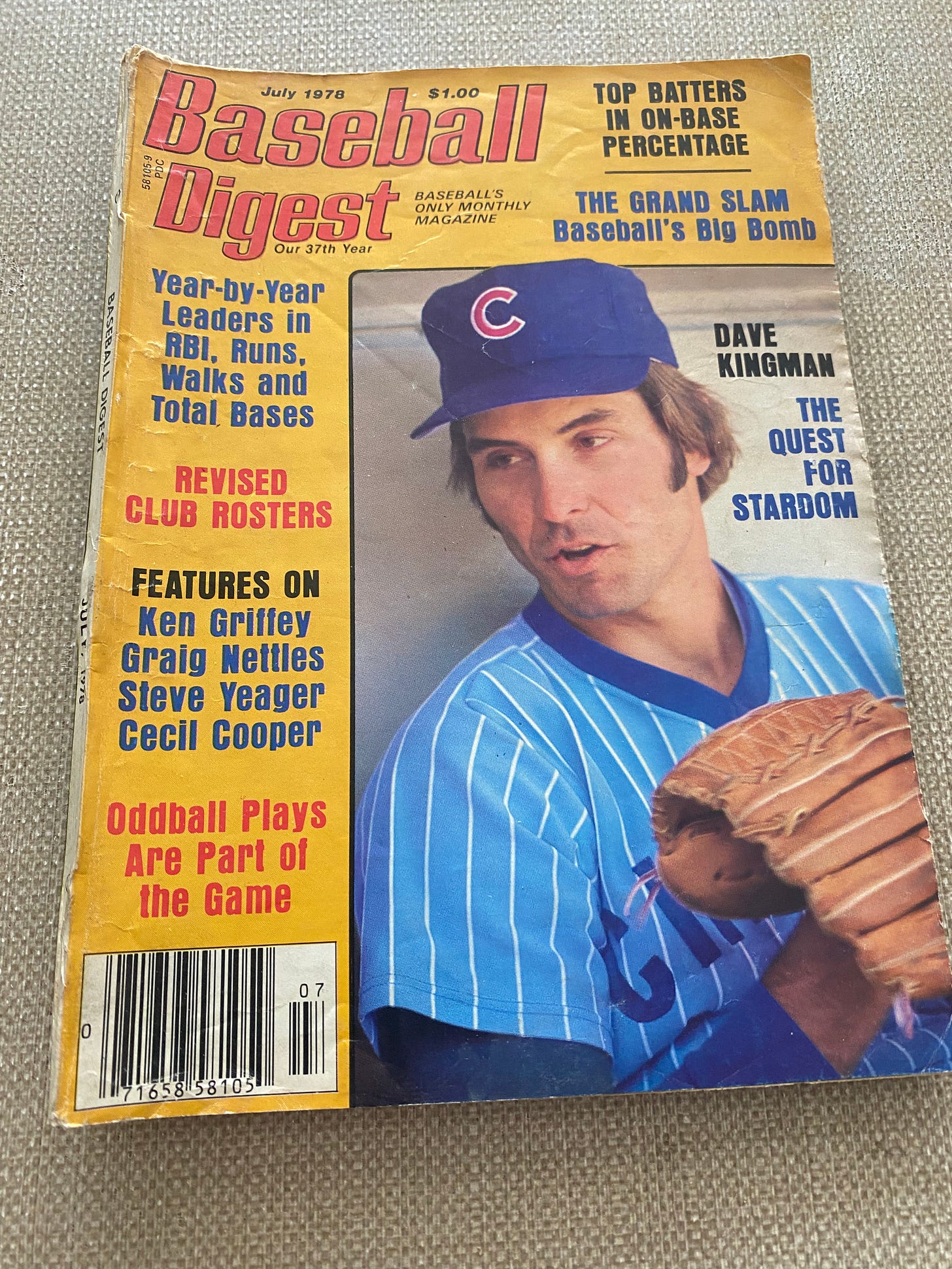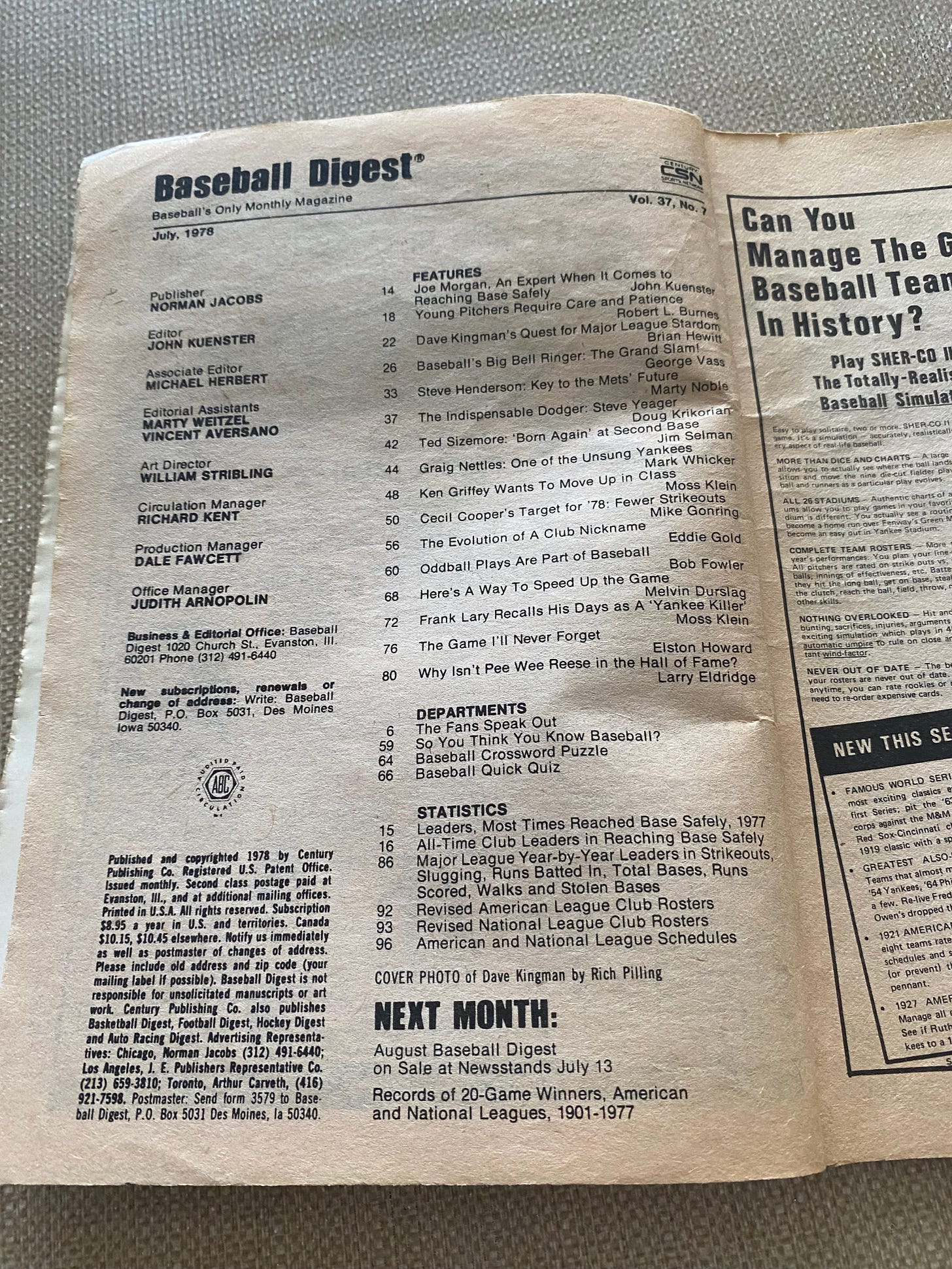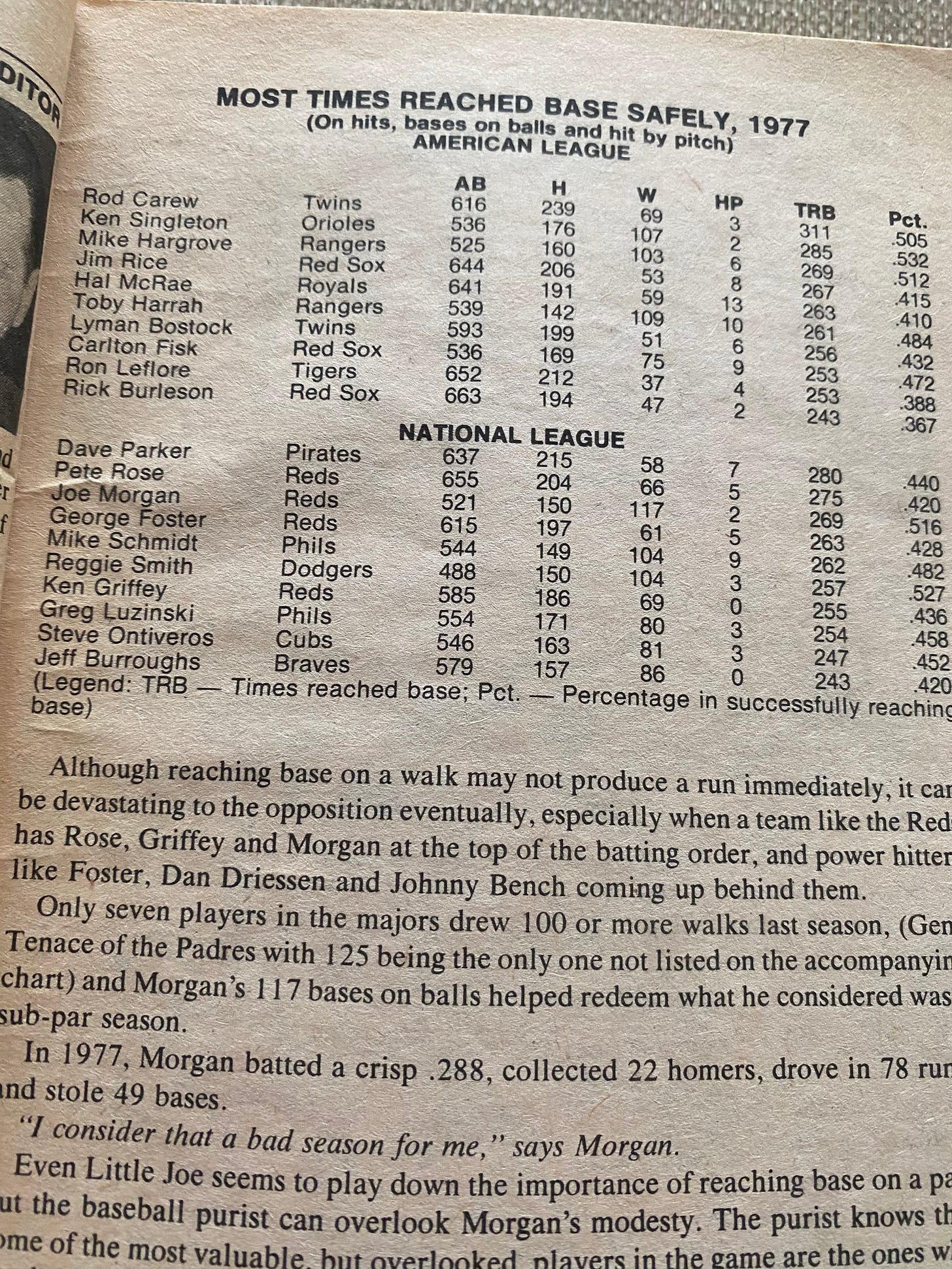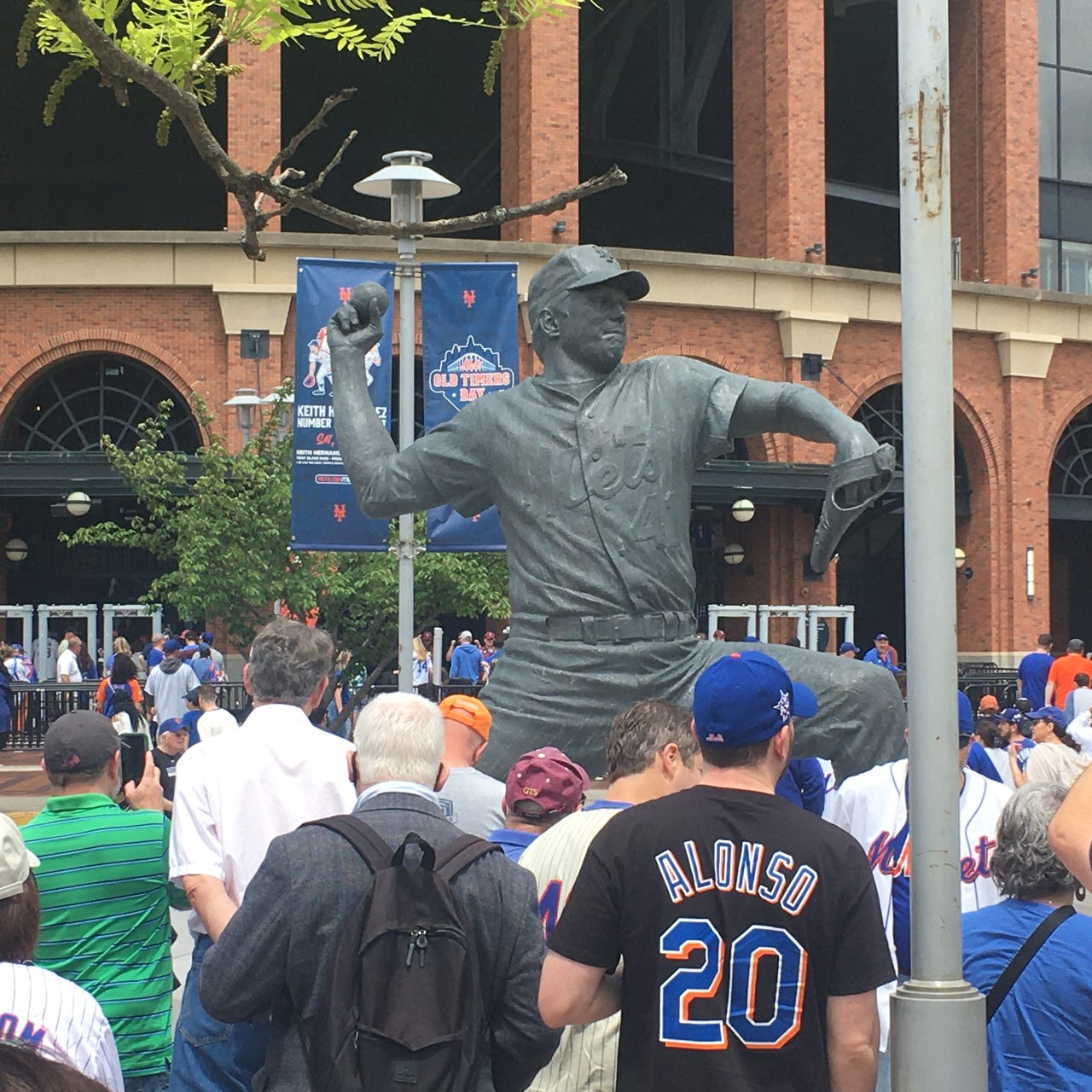July 1978
Dave Kingman’s career was an odd one. In one sense he was a precursor to the modern day slugger. See ball, swing hard, hit ball hard, ball travel far, strikeouts be damned. He was not a full blown Three True Outcomes hitter, however, in that he rarely drew walks. It’s not just that he would hit around .230, it’s that his on base percentages tended to fall below .300. Combine that with his atrocious defense and the fact that he was a difficult personality, it’s no wonder that he bounced around the league. But his years as a Chicago Cub stand out. His quest for stardom? It came close in Chicago. He only played 3 years with the Cubs, yet he totaled almost half of his career WAR in that time. His 1979 season was bonkers. Not only did he lead the NL in home runs for the first time in his career and also drove in more than 100 runs for the first time, but he also had a triple slash of .288/.343/.613. It’s as if he decided for that one year that he would be an all-around hitter and then just as quickly reverted to his old habits.
The article about speeding up the game was interesting. Tommy John offered his suggestions for improving the game pace, and he really thought out of the box. He said that the counts should be reduced to three balls for a walk and two strikes for a strikeout. His theory is that it would force hitters to be aggressive rather than take the first pitch and that pitchers would attack the strike zone; no nibbling. Or as he said, “the pitcher would immediately be ready to challenge the batter, and vice versa; this would quicken the pace of the game and make the customers happy.” Spoiler alert - no one ever took up his suggestion; he is best remembered for Tommy John Surgery and not for the Tommy John Rule.
The article on Joe Morgan focused on how his ability to draw walks greatly increased his value. It came with a chart; see if you can find the structural flaw.
If you said there is no way that Ken Singleton had an on base percentage of .532 in 1977 you would be correct. Whoever compiled the chart divided hits, walks, & hit by pitch by at bats, not by plate appearances. The math is incorrect. Morgan’s OBP in 1977 was .417, which is a great number, but not the .516 shown here, which is Barry Bonds territory.
This issue had a number of short articles. The Ken Griffey piece spotlighted his goal to win the NL batting title, more specifically his belief that he could hit .370 or .380 in the 1978 season. He wound up with a .288 average. Cecil Cooper, on the other hand, did reach his goal of cutting down on his strikeouts, although the fact that he had significantly fewer at bats in ‘78 helped. He kept the pattern going; he had relatively low strikeout totals for the remainder of his career. And “Why Isn’t Pee Wee Reese In the Hall Of Fame?” was still somehow a question in 1978. He would not get the call until 1978.
Finally, this issue contained a feature which showed up on occasion - updated club rosters. This edition would have hit newsstands in early June, yet it published rosters as they stood in early April. Despite that the info would not have been terribly out of date; in that era there was not much in-season roster churn. Teams generally attempted to end spring training by bringing north their best 25 along with the expectation that the majority of those 25 would remain with the team all year. Think about now; rosters from as recently as a week ago would largely be out of date by today. On top of that the trading deadline was June 15 back then. Roster construction ain’t what it used to be.
Most Memorable Moment - Colorado Rockies
MLB’s Original 1976 Choice: N/A
My Updated Selection: Matt Holliday slides into home plate. Or does he? (He doesn’t)
The first thing one thinks of with the Rockies are the insane run totals in the years before they began to use the humidor. I don’t know if they had specifically memorable moments in their first dozen years as much as a “did you see last night’s score?” vibe. Looking at individual stats could cause onlooker’s eyes to pop out of their skulls Looney Tunes style.
In recent seasons the Rockies have been a franchise seemingly without a plan, and now they are not just a bad team, but a bland, anonymous one. Long gone are the days of the absurd video game stats. Jayson Stark loves to make the “name 3 Marlins” joke, but it is just as applicable to the Rockies. The most memorable moment in franchise history took place in their greatest season, which was 2007. Based on the state of the team, I can’t see that changing anytime soon.
Their run to the 2007 NL pennant was completely unexpected. With 14 games left in the season, they were mired in 4th place and fully in the playing out the string portion of the season. And then suddenly they forgot how to lose. They won 13 of those final 14 regular season games and found themselves tied with the Padres for the wild card slot, necessitating a tiebreaking game. The teams were tied 6-6 after 9, and traded scoreless innings 10-12.
Scott Hairston broke the tie with a 2-run homer in the top of the 13th, but no lead is safe at Coors Field. The Rockies tied it up after only 3 batters, with a Matt Holliday triple driving in the tying run. After an intentional walk, Jamey Carroll lifted a fly ball to shallow right. Was it deep enough to score the winning run? Holliday tagged, and slid across home plate to win the game and send Colorado into the NLDS. Except… every camera angle shows that Holliday missed home plate. Replay review did not exist, so there was no mechanism in place to reverse the call. Yes, it is the most memorable Rockies moment, but it comes with an asterisk.
They may have gotten a break, but the Rockies took advantage of it. They continued to win and win and win some more, in a streak that would be dubbed “Rocktober.” They swept the Phillies in the NLDS & the Diamondbacks in the NLCS before it came crashing down when they were swept themselves by the Red Sox in the World Series. The year did not end in the way the Rockies had wished, but it remains the best season in franchise history, and the end of the tiebreak game is the franchise’s most memorable moment, whether Holliday touched home or not.
Pop
It wasn’t much of a surprise, but the announcement that Gregg Popovich will not return to the sidelines next season is one of those end of an era moments. The winningest coach in NBA history, Pop missed almost all of the 2024/25 season after suffering a mild stroke last November. He is stepping aside from the daily grind of coaching to serve as president of basketball operations with the San Antonio Spurs.
His career highlights are astonishing. In addition to that career victories record, he coached the Spurs to 5 NBA titles, and most importantly he was adaptable; he did not limit himself to one technique to achieve that success. His nearly 30 year run as Spurs coach encompassed multiple eras, and he won using various styles depending upon his personnel at the time. The Tim Duncan led Spurs did not play the same way that the Kawhi Leonard led Spurs did; Popovich won with both. He has left a legacy; his coaching tree is expansive. Winning coaches such as Steve Kerr, Mike Budenholzer, Ime Udoka, Becky Hammon, and so many more have either played for or coached with him.
If there is one central characteristic of Pop, it’s that he tolerated no bulls***. OK, sometimes he would go too far in ostentatiously pointing out the absurdity of the in-game coaches interview, but he did it to make a point. Just like he shamed the league into easing up on the scheduling. The infamous night in which he sat almost all of his starters in a nationally televised game, incurring the wrath of David Stern, came because the Spurs were in the midst of a four games in five nights stretch. That type of heavy scheduling does not take place anymore. And Popovich was also proudly outspoken on political and social issues. He never hid his disgust for the current occupant of the White House.
It’s a little unfortunate that his health forced him to leave coaching only 2 seasons into the Victor Wembanyama era. Several years of the Wemby Experience would have been a nice coda to a great career. That’s only a minor issue. It’s not as if that leaves a chasm in his résumé. Bon voyage, Pop.
R.I.P.
There are a few recent passings which merit mention, beginning with Naismith Hall Of Famer Dick Barnett. The 2-time NBA champion New York Knicks from the early 1970’s are one of the most fondly remembered teams in league history, the 1970 team in particular. That was the year which included both an injured Willis Reed’s dramatic emergence from the tunnel and Walt Frazier’s brilliant Game 7 performance. Barnett was the starting 2 guard on that team (Earl Monroe was still playing in Baltimore that season) and although not as flashy as his teammates he was a quintessential glue guy. He was nearing the end of his career during the 1973 season and was largely out of the rotation, but he earned a second ring that year, and following his playing career he went on to earn a PhD in education. Dick Barnett was 88.
Jill Sobule is best known for her hit single I Kissed A Girl back in 1995. Although she never again matched those commercial heights, she maintained a steady career, constantly touring & releasing new music on indie labels. She had also recently written an acclaimed autobiographical musical. Sobule was tragically killed in a house fire late last week. She had largely fallen off of my radar, so I was not prepared for the outpouring of emotion among those who mourned her on social media. She made an obvious impact on her audience. Jill Sobule was 66.
For a show that was such a huge cultural phenomenon, it was always striking to see the way that so many stars from Rowan & Martin’s Laugh-In struggled to remain relevant in the years after the show ended. Lily Tomlin and Goldie Hawn aside, the rest of the cast were largely reduced to appearing in the Love Boat/game show circuit. Ruth Buzzi was one example. She was one of the top stars during the show’s entire run, and Gladys Ormphby smacking Arte Johnson on the head with her purse was a signature image from the show. Buzzi did go on to have a successful second act to her career in children’s television - although it’s safe to say that the fans she made from her Sesame Street appearances in the 1990’s were not Laugh-In fans - and she was a popular presence on social media. Buzzi was 88.
50 Years Ago - When Things Were Rotten
Men In Tights was not the first time that Mel Brooks tackled the Robin Hood legend. He co-created & co-produced a short lived sitcom take on the tale back in 1975. It was exceptionally silly even by Brooks’s standards, meaning that it was right in the wheelhouse for a 9 year old such as I was at the time. I can still hum the title song all these years later. I’m not proud.
Brooks populated the cast with some old friends from the Get Smart days. Dick Gautier portrayed Robin Hood, and Bernie Kopell was one of the Merry Men. There were other familiar names found here. Dick Van Patten played Friar Tuck, and long time Hee Haw cutie pie Misty Rowe was Maid Marian. The show was also sure to follow the sitcom formula of the era. Both the Sheriff Of Nottingham and Prince John were your standard bumbling sitcom antagonists. Think Hogan Heroes levels of villainy. And no show could be complete without a gimmick. There was a pair of identical twins in the cast, one with the Merry Men and one a member of the king’s inner circle, both portrayed by the same actor.
When Things Were Rotten only ran for 13 episodes; I’m fairly confident that I watched most if not all of them. The episodes are all available on YouTube, but I am not tempted in any way to sample any of them. This is a show that I prefer to remember through my childhood prism. I would suspect that the inherent silliness hasn’t aged well. The opening credit sequence embedded below gives you an idea of the wacky tone of the show. I have vague memories that Kopell frequently broke the fourth wall with lots of winking at the audience, but I might be wrong about that.
In the end, When Things Were Rotten is a minor entry in Mel Brooks’s body of work. Mention the show to someone even 3 years younger than I am and you’re likely to be met with blank stares. I won’t claim that it is The Great Lost Show, but it entertained me.
Closing Laughs
I hope your horse won on Saturday - not a euphemism. Have a great day everyone, and I will see you on Wednesday.







